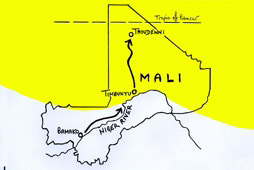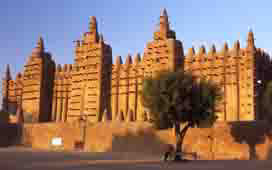
 Djenné Mosque
Djenné Mosque
 Djenné Mosque
Djenné MosqueOn a whim I took an evening bus downriver to the small fishing town of Massina. As at Koulikoro, a shadowy figure led me silently under the moonlight to the campement, a collection of circular huts by a well. Massina has no electricity, so I searched for supper among lantern-lit stalls before groping in the darkness for my hut, bed and mosquito net.
Next morning I set off at sunrise, intending to hitch-hike downstream to the village of Diafarabé, but got no further than the village centre where the weekly market was getting under way. During the night several huge pinasses had pulled up and their produce was now spread out on the riverbank. At the same time lorries, minibuses and a hundred donkey-carts had arrived to clog the tree-lined backstreets. Stalls were being laid out with vast quantities of fish, vegetables, fruit, clothing, cosmetics, medicines and motorbike spares. At first I thought the arrangement was random, things being offered for sale from wherever they were dropped, but as the day wore on I realised that rudimentary quarters had started to develop. The watermelon quarter was at the south end where there was the space that these giants needed; fish were in two groups on the beach; cloths and clothing were behind a windbreak so they wouldn’t blow away; and of course the motorbike spares were alongside the main road.
Needless to say, I never got to Diafarabé.
With the river still too low for long-distance pinasses I returned to Ségou and set off eastwards by road. An advantage of this was that I would be passing the ancient city of Djenné on the banks of the Bani, a tributary of the Niger. It turned out to be at the end of a 20-mile cul-de-sac – not an insuperable problem, you might think, but although Djenné has a population of 10,000 I waited several hours at the turnoff before a vehicle passed. Luckily, this being Mali, its passengers bunched up and a square inch of seat was found for me.
Djenné is unlike any other city in Mali, or indeed in the world. Built entirely of mud, its flamboyant houses are designed according to Tukulor or Moroccan principles with a clear division of uses – front rooms for men, back rooms for women, with animals in the courtyard in between. On my second morning I went out early and found the still dark streets clogged with goats. This was apparently the time of day when they were booted out of the courtyards to find grazing. The animals ran panicking ahead of me, the only human being out and about at that hour. Eventually they veered off baying into what looked like allotments but what I hoped was waste ground. Did an angry allotment gardener lose his lettuces that morning? How do Djenné’s goat-owners ever find them at the end of the day? I didn’t see the place or the goats again, so will never know.
Djenné’s crowning glory is its central mosque, the largest mud structure in the world. Despite being no more than 30 metres high, it manages to dwarf the Lilliputian mud city around it. Like all Djenné’s buildings it suffers terribly from erosion during Mali’s annual rains, so each November an energetic repair job takes place, when local men become ‘mud masons’, clinging precariously to its famous protruding beams.
I liked Djenné. Despite the notorious tourist touts (and there are lots), I found its people down-to-earth and welcoming. Two families even invited me into their houses, something that doesn’t often happen to passers-by in my roughly comparable home town of Winchester. But then at 5am in Winchester, you don’t find the streets clogged with goats.
On my third morning I squeezed with twelve other people into a bâchée or shared taxi bound for Mopti. Built on three islands connected by dykes, the city is a newcomer by Mali standards, having become important merely a century ago when the French built a small harbour, the only one on the Niger’s 1,500-mile passage through Mali. They chose well: Mopti immediately flourished and it now vies for the honour of being Mali’s second city. Among foreigners, unfortunately, it has a reputation for persistent and aggressive touts, so I approached the waterfront braced for confrontation. As so often happens, my fears were unfounded. Perhaps at such an early hour the touts were still in bed.
By sunrise the port was in full swing. Pinasses were unloading freight or picking up passengers, and round the harbour stallholders were stirring and setting out their wares. As at Massina they grouped themselves by product. I started on the south side and passed fishmongers, tobacco merchants and chilli sellers. Basket and prayer-mat salesmen were round the corner to the east. Finally I turned onto the northern promenade and couldn’t believe my eyes. Neatly lined up were a dozen stalls displaying neatly stacked slabs of something I instantly recognised from my time in Bolivia – salt. Some of the blocks were gigantic – a metre across and weighing probably 20 kilos. Others had been carved up into smaller chunks and sparkled like tablets of Kendal Mint Cake in the morning sun.
I approached a Moorish-looking stallholder and pointed to a glistening pile. “Where do these come from?” I asked. “Taoudenni, Taoudenni!” he replied, waving a hand airily towards the north. “And how much is this one?” I continued. “For you, toubab, 1,500 francs!”
So this was where they ended up – those great slabs so painfully hewn from beneath the heart of the Sahara. Soon the purest ones would be broken up and crumbled into crystals to be put on people’s dinner tables. The rest would be taken by herdsmen for their animals. Even assuming that the artful Moor had quadrupled his price on seeing a foreigner, the going rate in Mopti would still be 40p per kilo – not a bad markup on the 8p that the Taoudenni miners receive. The voyage upriver would account for some of the increase; the merchants in Timbuktu would no doubt also have taken their share; but the bulk of the markup would have gone to the camel-drivers. It is this income, perhaps 32p per kilo for a top-quality slab, that has kept the Taoudenni salt trade alive for 1,000 years. How much longer the camel-drivers will consider it worth the gruelling 450-mile journey is another matter.
Before carrying on downriver I decided to make a detour into Mali’s only mountain range. Actually ‘range’ is perhaps an exaggeration, but the soaring volcanic plugs which dot the landscape around the village of Hombori are stunning nevertheless. Varying from finger-like needles to vast flat-topped mesas covering several square miles, they include some of Africa’s highest cliff faces (with some fabulous new routes waiting for those climbers amongst you, incidentally). A colony of monkeys is reputed to live on top of the Lost World-like slab of Hombori Tondo, Mali’s highest peak. But the one I liked best was the 1,000-metre Main de Fatima, a cluster of two needles and a slab which from certain angles looks exactly like a hand with the thumb slightly bent and the index finger pointing to the sky. Wandering across the plain, I watched entranced as the setting sun threw shadows round this gigantic natural sculpture; and I was there again at dawn as its pink basalt cliffs turned to fire in the first rays of morning.
But it was time to move on. Back in Mopti, pirogues were leaving daily for the villages and larger boats occasionally for further afield. I bought a ticket for the Général Soumaré which was departing on Christmas Eve for the 100-mile journey to the village of Niafounké, home of the legendary musician Ali Farka Touré. The voyage would involve crossing the Niger’s most famous and enigmatic feature, the ‘inland delta’, and at its heart the vast (and at this time of year worryingly shallow) Lac Débo.
I prepared myself to spend Christmas Day
stuck on a sandbank.
